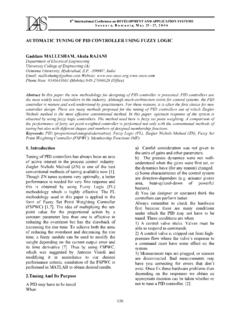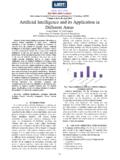Transcription of Interval Type-2 Fuzzy Logic Toolbox - Engineering Letters
1 Engineering Letters , 15:1, EL_15_1_14. _____. Interval Type-2 Fuzzy Logic Toolbox Juan R. Castro, Oscar Castillo, Luis G. Mart nez originally presented by Zadeh in 1975 and are essentially Abstract This paper presents the development and design of Fuzzy Fuzzy sets where the Fuzzy degree of membership is a a graphical user interface and a command line programming type-1 Fuzzy set [4,6]. The new concepts were introduced by Toolbox for construction, edition and observation of Interval Mendel and Liang [8,10] allowing the characterization of a Type-2 Fuzzy Inference Systems. The Interval Type-2 Fuzzy Type-2 Fuzzy set with a superior membership function and an Logic System Toolbox (IT2 FLS), is an environment for Interval inferior membership function; these two functions can be Type-2 Fuzzy Logic inference system development. Tools that cover the different phases of the Fuzzy system design process, from the represented each one by a type-1 Fuzzy set membership initial description phase, to the final implementation phase, build function.
2 The Interval between these two functions represent the Toolbox . The Toolbox 's best qualities are the capacity to the footprint of uncertainty (FOU), which is used to develop complex systems and the flexibility that permits the user characterize a Type-2 Fuzzy set. to extend the availability of functions for working with the use of The uncertainty is the imperfection of knowledge about the Type-2 Fuzzy operators, linguistic variables, Interval Type-2 natural process or natural state. The statistical uncertainty is membership functions, defuzzification methods and the the randomness or error that comes from different sources as evaluation of Interval Type-2 Fuzzy Inference Systems. we use it in a statistical methodology. There are different sources of uncertainty in the evaluation Index Terms Interval Type-2 Fuzzy Inference Systems, and calculus process. The five types of uncertainty that Interval Type-2 Fuzzy Logic Toolbox , Interval Type-2 . emerge from the imprecise knowledge natural state are: Membership Functions, Footprint of Uncertainty.
3 I. INTRODUCTION Measurement uncertainty. It is the error on observed quantities. On the past decade, Fuzzy systems have displaced Process uncertainty. It is the dynamic randomness. conventional technology in different scientific and system Model uncertainty. It is the wrong specification of Engineering applications, especially in pattern recognition and the model structure. control systems. The same Fuzzy technology, in Estimate uncertainty. It is the one that can appear approximation reasoning form, is resurging also in the from any of the previous uncertainties or a information technology, where it is now giving support to combination of them, and it is called inexactness and decision making and expert systems with powerful reasoning imprecision. capacity and a limited quantity of rules. Implementation uncertainty. It is the consequence of The Fuzzy sets were presented by Zadeh in 1965 [1,2]. the variability that results from sorting politics, to process / manipulate data and information affected by incapacity to reach the exact strategic objective.
4 Unprobabilistic uncertainty / imprecision. These were designed to mathematically represent the vagueness and uncertainty of II. Interval Type-2 Fuzzy SET THEORY. linguistic problems; thereby obtaining formal tools to work with intrinsic imprecision in different type of problems; it is A. Type-2 Fuzzy Sets Concept considered a generalization of the classic set theory. Intelligent Systems based on Fuzzy Logic are fundamental A Type-2 Fuzzy set [6,7] expresses the non-deterministic tools for nonlinear complex system modeling. The Fuzzy sets truth degree with imprecision and uncertainty for an element ~. and Fuzzy Logic are the base for Fuzzy systems, where their that belongs to a set. A Type-2 Fuzzy set denoted by A , is objective has been to model how the brain manipulates inexact characterized by a Type-2 membership function A~ ( x, u ) , information. Type-2 Fuzzy sets are used for modeling uncertainty and where x X, u J x [0,1] and 0 . u A~ ( x, u ) 1 defined imprecision in a better way.
5 These Type-2 Fuzzy sets were in equation (1). A = {( x , A~ ( x )) | x X }. ~. Oscar Castillo is with the Division of Graduate Studies and Research in Tijuana Institute of Technology, Mexico (corresponding author phone: 52664- ~. { }. A = ( x , u , A~ ( x , u )) | x X , u J xu [ 0 ,1] (1). 623-6318; fax: 52664-623-6318; e-mail: An example of a Type-2 membership function constructed in Juan R. Castro is a graduate student in Science and Engineering with the the IT2 FLS Toolbox was composed by a Pi primary and a Division of Graduate Studies and Research in Baja California Autonomous Gbell secondary type-1 membership functions, these are University, Tijuana Campus, Mexico (e-mail: Luis G. Martinez is a graduate student in Science and Engineering with the depicted in Figure 1. Division of Graduate Studies and Research in Baja California Autonomous University, Tijuana Campus, Mexico (e-mail: (Advance online publication: 15 August 2007). Engineering Letters , 15:1, EL_15_1_14.)))
6 _____. Fig. 2. FOU for Gbell Primary Interval Type-2 Membership Functions. Fig. 1. FOU for Type-2 Membership Functions. B. Fuzzy Set Operations ~. If A is continuous it is denoted in equation (2). We can apply some operators to the Fuzzy sets, or we can ~ make some operations between them [4,10,11]. When we A = f x (u ) / u / x (2) apply an operator to one Fuzzy set we obtain another Fuzzy set;. x X u J xu [ 0,1] by the same manner when we combine an operation with two ~ or more sets we obtain another Fuzzy set. If we have two where denotes the union of x and u. If A is discrete then ~ ~. Type-2 Fuzzy subsets identified by the Letters A and B , it is denoted by equation (3). associated to a linguistic variable, we can define three basic operations: complement, union and intersection (TABLE I). ~ N M i . A = A~ ( x) / x = f xi (uik ) / uik / xi (3). x X i =1 k =1 TABLE I. where denotes the union of x and u. Name Interval Type-2 Fuzzy Set Operations.
7 Operator Operation u u f x (u ) = 1, u [ J x , J x ] [0,1] , the Type-2 ~ ~. If Union = join . A B ={ ~ ( x) ~ ( x) }. ~. A. ~. B. membership function A~ ( x, u ) is expressed by one type-1 x X. inferior membership function, J x . u A (x) and one type-1.. u = 1 / / x . x X [ A~ (x) B~ (x), A~ (x) B~ (x)] . superior, J x A (x) (Fig. 2), then it is called an Interval Type-2 Fuzzy set [8] denoted by equations (4) and (5). ~ ~. ~ ( x, u ,1) | x X , Intersectio n = meet . A B ={ ~ ( x) ~ ( x) }. x X. ~. A. ~. B. A= (4). u [ A ( x), A ( x)] [0,1] . or = 1 / / x . x X [ A~ (x) B~ (x), A~ (x) B~ (x)] . ~ . A= 1/ u / x Negation ~ . x X u [ J ux , J ux ] [ 0,1] A = A~ ( x) / x . (5) x X .. = . 1/ u / x . x X u [ A ( x ), A ( x )] [ 0,1] = 1 / / x . ~ x X [1 A~ ( x ),1 A~ ( x ) ] . If A is a Type-2 Fuzzy Singleton, the membership function is defined by equation (6). 1 / 1 si x = x'. A~ ( x) = (6). 1 / 0 si x x'. (Advance online publication: 15 August 2007).
8 Engineering Letters , 15:1, EL_15_1_14. _____. C. Fuzzy Inference System reductor transforms a Type-2 Fuzzy Set into a Type- The human knowledge is expressed in Fuzzy rule terms with 1 Fuzzy Set. the next syntaxes: Knowledge Base. Contains a set of Fuzzy rules, and a membership functions set known as the database. IF < Fuzzy proposition> THEN < Fuzzy proposition>. The Fuzzy propositions are divided in two types , the first one is named atomic: x is A, where x is a linguistic variable and A is a linguistic value; the second one is called compounded: x is A AND y is B OR z is NOT C, this is a compounded atomic Fuzzy proposition with the AND , OR . and NOT connectors, representing Fuzzy intersection, union and complement respectively. The compounded Fuzzy propositions are Fuzzy relationships. The membership function of the rule IF-THEN is a Fuzzy relation determined by a Fuzzy implication operator. The Fuzzy rules combine one or more Fuzzy sets of entry, called antecedent, and are associated with one output Fuzzy set, called consequents.
9 The Fuzzy Sets of the antecedent are associated by Fuzzy operators AND, OR, NOT and linguistic modifiers. The Fuzzy rules permit Fig. 3. Interval Type-2 Fuzzy Reasoning. expressing the available knowledge about the relationship between antecedent and consequents. To express this The decision process is a task that identifies parameters by the knowledge completely we normally have several rules, inference system using the rules of the rule base data. These grouped to form what it is known a rule base, that is, a set of Fuzzy rules define the connection between the input and rules that express the known relationships between antecedent output Fuzzy variables. A Fuzzy rule has the form: IF. and consequents. The Fuzzy rules are basically IF <Antecedent> THEN <Consequent>, where antecedent is a <Antecedent> THEN <Consequent> and expresses a Fuzzy compound Fuzzy Logic expression of one or more simple Fuzzy relationship or proposition. expressions connected with Fuzzy operators; and the In Fuzzy Logic the reasoning is imprecise, it is consequent is an expression that assigns Fuzzy values to approximated, that means that we can infer from one rule a output variables.
10 The inference system evaluates all the rules conclusion even if the antecedent doesn't comply completely. of the rule base and combines the weights of the consequents We can count on two basic inference methods between rules of all relevant rules in one Fuzzy set using the aggregate and inference laws, Generalized Modus Ponens (GMP). operation. This operation is analog in Fuzzy Logic to the S- [5,6,8,13] and Generalized Modus Tollens (GMT), that norm operator. represent the extensions or generalizations of classic reasoning. The GMP inference method is known as direct reasoning and is resumed as: Rule IF x is A THEN y is B. Fact x is A'. _____. Conclusion y es B'. Where A, A', B and B' are Fuzzy sets of any kind. This relationship is expressed as B ' = A' ( A B ) . Figure 3. shows an example of Interval Type-2 direct reasoning with Fig. 4. Type-2 Inference Fuzzy System Structure. Interval Type-2 Fuzzy Inputs. An Inference Fuzzy System is a rule base system that uses Fuzzy modeling is a task for parameter identification in a Fuzzy Logic , instead of Boolean Logic utilized in data analysis Fuzzy inference system to obtain an adequate behavior.







